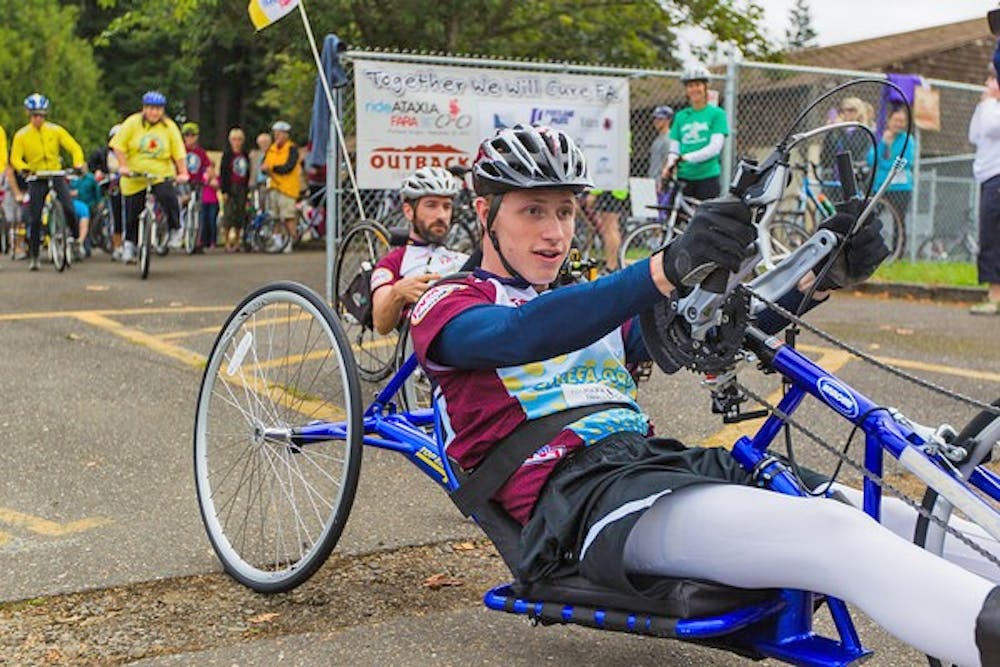By Peter Gallagher |
Sam Bridgman is no stranger to adversity. Diagnosed with Freidreich’s ataxia (FA) at the age of 15, the tall, athletic Bridgman faced the reality of a life without the use of his legs as the disease would progressively limit his basic motor skills and lead to a host of issues associated with muscular atrophy. But in Bridgman, FA had found an opponent that refused to take anything sitting down.
Seven years later, in a YouTube video seen by over 130,000 people, Bridgman, aided by two others, stood up from his wheelchair and walked across the stage at the University of Portland graduation to a standing ovation. A campus celebrity and staple of the UP baseball program, Bridgman confronted another startling reality once he received his diploma: postgraduate life.
Since graduation in May, Bridgman started a job at Nike, moved into an apartment with his brother Max in northeast Portland, and continues to frequent UP baseball games. Yet, he still cannot help but wax nostalgic about his time at the University.
“I think just being around such a generous community, a community I know has my back and I have theirs, it’s just a great place to be,” Bridgman said of UP. “One of the bigger changes (since graduating) is just being in the real world, starting a job.”
The real world, for Bridgman, includes a daily routine that involves intense physical exertion to complete some of the mundane tasks so many often take for granted. Bridgman’s love for baseball helps him to put such challenges in perspective.
“I think sports can relate a lot to life. I tell a lot of people that I look at life like a baseball game,” Bridgman said. “When I wake up every morning it’s like I’m doing batting practice. I’m stretching on the field when I take a shower. When I eat breakfast, that’s my pre-game meal. When I go to work, that’s my game. When I come back and eat dinner, that’s my post-game workout. Then get in bed and get ready for the next day. The next game.”
Last Saturday, Bridgman partnered with Ride Ataxia, a national foundation that raises money for FA research through bike rides in six cities across the United States, to organize an event on Sauvie Island. One hundred and seventy five participants took part in the ride, which raised over $45,000 by Monday. Kyle Bryant, who was diagnosed with FA in 1998, founded Ride Ataxia after a bike trip with his father from San Diego to Memphis in 2007.
“My goal was to raise $30,000, and I had no idea how we were going to get there,” Bryant said. “We ended up raising $40,000 that trip. The whole FA community got really excited about it. We did another big ride in 2008 and that’s when I met Sam.
“This is our least expensive ride to pull off because of the support we get from UP. That’s huge. Because the point of the ride, the bottom line, is we’re here to raise money for research to find a treatment and a cure. And UP makes it easier. They push us along to that goal.”
Laurie Kelley, associate vice President for University Relations and close friend of Bridgman, has been an integral part of UP’s cooperation with Ride Ataxia. Though she initially heard of him through his other annual event Sam Jam, a wheelchair basketball fundraiser held annually at the Chiles Center, Kelley had not given Bridgman or Ride Ataxia much thought. But that was soon to change.
“One day he just wheeled in here and that was the end of it,” Kelley laughed. “We’ve been really good friends ever since. Everyone who knows Sam really wants to be involved with him.”
Kelley, alongside fellow UP faculty Bill Reed and Gwynne Kobes, helped Ride Ataxia with organization, event planning and production of the ride’s T-shirts.
“The close-knit community, especially at UP, they’ve been our big supporter,” Bridgman said. “Laurie has been a huge supporter.”
Felicia DeRosa is the program director at the Friedreich’s Ataxia Research Alliance (FARA), the nationwide nonprofit responsible for Ride Ataxia and a host of other fundraising efforts focused on FA research. Though instrumental in the organization and execution of Ride Ataxia alongside Bryant, she is quick to shift the credit elsewhere.
“Really, Sam is the one who pulls it all together,” DeRosa said.
FARA has played an incalculable role in raising public awareness of the disease. They are the guiding light in the medical community’s incessant search for a cure. And many feel that the search will soon come to a close.
“People go, ‘Oh, let’s cross our fingers and pray for a treatment or a cure,’” Bryant said. “We are doing that, for sure, but we are so confident in our science that we’re just going to keep pushing. We definitely want luck on our side, but we don’t need it.”
Though he has inspired many in the FA and UP communities, Bridgman does not hesitate when asked to list his own role models.
“When I look for inspiration, the first people I look at are my parents. And then, honestly I probably look at Kyle,” Bridgman said as he turned to face Bryant. The two exchanged wry smiles, and Sam began to blush. “Well, this is awkward,” Bryant chimed as he turned to look into his lap.
The two then faced each other once more and began to chuckle. Bryant extended his fist for a bump and Bridgman met him halfway. For a moment, the fight was theirs.








